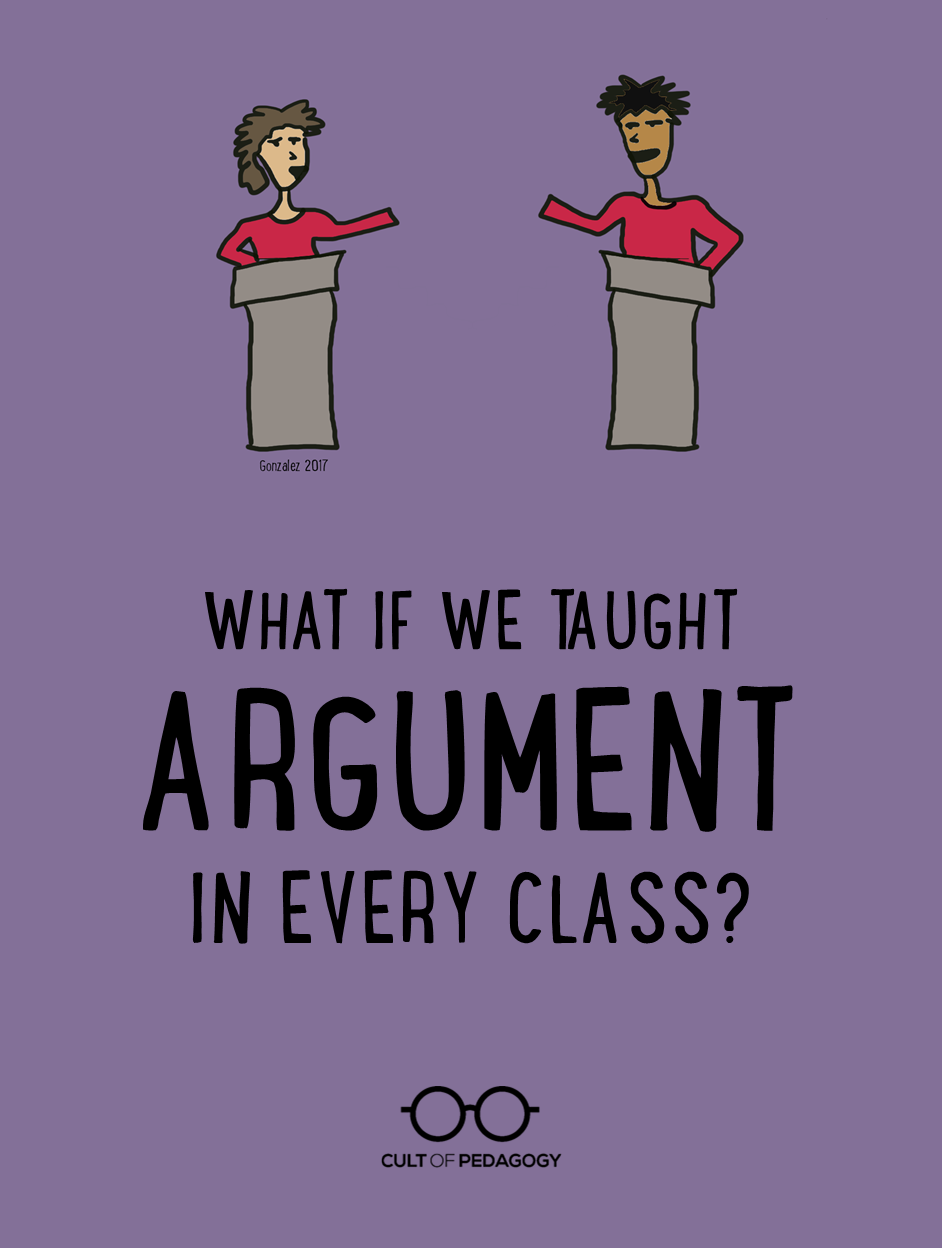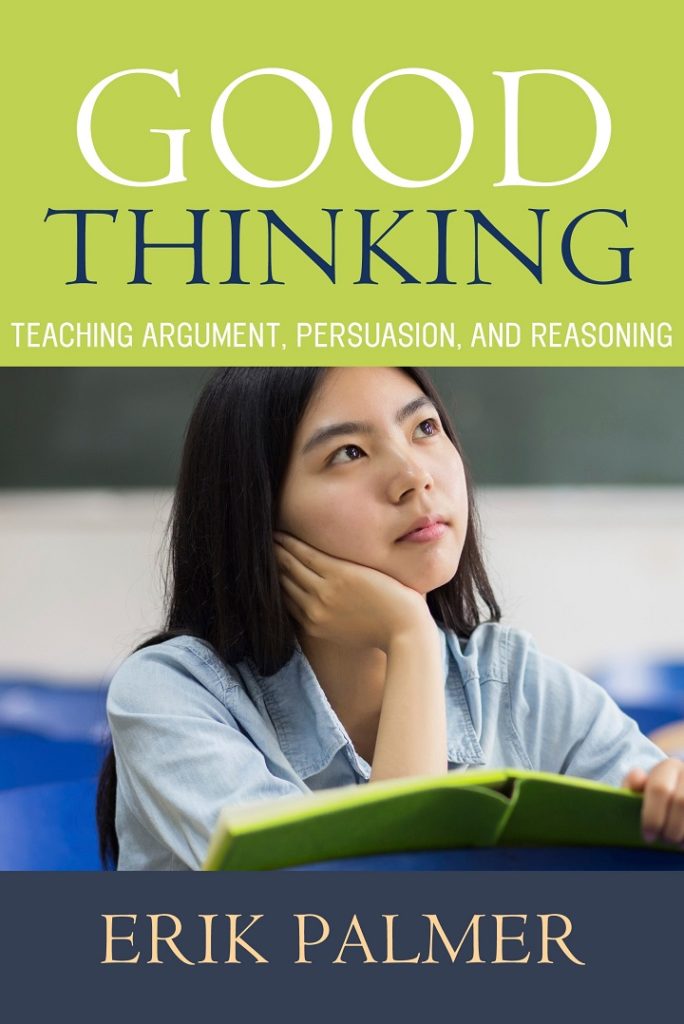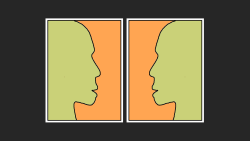
This post contains Amazon Affiliate links; if you purchase from Amazon after going through these links, Cult of Pedagogy receives a small commission at no extra cost to you.
Sometimes when scrolling through Facebook, I click on an article that looks interesting. And sometimes I keep scrolling past the article into the comments.
Why? Why would I torture myself like this? It’s like a compulsion, I can’t look away. I’m sucked into the mire that is the comment section and I sink quickly into the dark underbelly of the Internet. And while there, I start to question humanity.
What has the world come to? Who is reading this stuff? (Oh crap. I am. I am reading this stuff). What is wrong with these people? Where do their facts come from? Wait, just kidding, these aren’t facts, they’re mindless opinions of the staggering hoards of people writing mean, baseless comments on the Internet. Get out! Get out!
And you know what I realize after all of this? I realize I must, absolutely must, teach my students how to argue. And how to think. I cannot allow them to go into the world as Internet trolls. I know I’m guilty of assuming my kids already know how to argue. I mistakenly believe it’s an inherent skill, that thinking logically is natural.
Of course, this is not the case.
And now, potentially more than ever, our students must learn to think logically, present rational conclusions, see through faulty logic, and share their opinions in a convincing way.
Here to help: Erik Palmer.
In his book, Good Thinking: Teaching Argument, Persuasion, and Reasoning, Palmer shows us how to teach our students to wade through the deluge of arguments they face on a daily basis, to discern the good from the bad, and to know when they’re being duped by persuasive tricks. He offers solutions that can be put into action tomorrow, strategies we can use throughout the year to develop students’ reasoning skills. And most of these strategies are surprisingly simple. “By making small adjustments to what we already do,” Palmer says, “we can develop better thinking in all students.”
Big Ideas
We work hard to help our students read, write, and speak, but how much do we actually teach them to think? Palmer believes we’re not doing this enough, and he advocates we do much more by using argument, reasoning, and persuasion. Our reasoning skills, Palmer says, are used all the time: “We analyze the messages we receive. We reason with with others. We even reason with ourselves.” If we can help students see the argument in a variety of situations, in and out of the classroom, we can help them better understand how to construct and deliver their own thoughts.
Start with a shared language. Palmer suggests beginning by defining the words students need to know: argument, conclusion, premise (or statement for younger students), and evidence. Again, we think kids know these terms, but all too often, they don’t. The most important thing is to keep the language consistent across classes, subjects, and grades.
Honestly, to me this is probably the most difficult idea proposed in the whole book. It’s hard enough for just my department to be consistent with things, much less our faculty of 250! However, I can see his point. If every teacher uses this language in their classrooms, won’t students become experts?
Incorporate argument all year in every classroom. By spreading argument throughout the year, we can help students become familiar with all of the elements, work it into more of their practice and assignments, and encourage them to find arguments everywhere. If the goal is to create young people who can hold their own in the real world, then we need to bring the real world in for inspection. Once kids are attuned to the parts of an argument, they will begin to find them everywhere. With that, they will hopefully begin to question them as well.
Demand evidence for every argument. Raise your hand if you’ve said to your students “Make sure you support your point with evidence.” Both of my hands are up. That’s what we’re supposed to do, right? I won’t accept a response unless you can back it up.
Except oftentimes they can’t. Why not?
Because, once again, I am assuming they know what I mean by evidence. Just because evidence and information are common words, doesn’t mean the kids know what we mean when we use them. Teachers should help students identify types of evidence and should never allow students to make a statement without using evidence to support it.
Add persuasive techniques. Palmer spends one chapter discussing how to move from argument to persuasion. He uses the words cold and hot to explain the difference: “An argument is cold: it is made up of passionless sentences that lead us to a passionless conclusion. Persuasion is hot: it consists of tricks we use to make others care about that cold argument.” In this chapter he illustrates common persuasive techniques with examples.
Activities Across the Curriculum
Palmer presents myriad activities for identifying, creating, and strengthening arguments, many that can be applied in different subject areas, even social-emotional learning. In addition to the activities presented at the end of each chapter, an additional chapter lists potential problems with teaching argument and offers actionable solutions. Another presents eighteen additional activities that can be used in almost any grade or subject to develop reasoning skills. As I read through the activities, I found several that could be used throughout the year, not just in specific units.
- Find Hidden Arguments: Periodically present conversation snippets to students and have them put together the argument hidden in the seemingly everyday conversation. These could be collected by the teacher and the students and shared throughout the year.
- Categorize Vocabulary Words: After being presented with a list of vocabulary words (at once or over time), students categorize the words and then build arguments to justify their choices. This would allow them to work with words while also building their reasoning skills.
- Artwork as Argument: Students study a piece of art (Picasso’s Guernica, for example). From the work, they write a conclusion, and then students can use details and choices in the art to write statements and find evidence to back up their conclusion.
- Commercials as Persuasive Practice: I am so excited about this idea! After students have become very familiar with argument and have studied persuasion, have each student create a commercial for any product they want (real or fake). The requirements would include using identifiable persuasive techniques. Students can record commercials or give them live. Here’s the fun part: Use them as brain breaks. When we’re transitioning from notebook prompts to reading The Great Gatsby, say “Before we begin, let’s pause for a message from our sponsors” or something, and then a student (who knew they’d be going this week), shares their commercial. Isn’t that fun!?!
How This Book is Impacting My Teaching
I started reading this book just three weeks before my students began their argument essay unit. Talk about perfect timing! This week, as a matter of fact, my students and I have defined the terms as Palmer suggests, then we looked at and created syllogisms, expanded those to larger arguments including evidence, and identified faulty logic. There is so much more to be done, but as an intro to argument and a base for their essay, it will do for now. Here are some other ways Good Thinking has impacted my teaching:
- Evidence charts: In the past I just called evidence “support” and usually meant quotes, but after reading Palmer’s book I see how vague that was. When kids are researching and writing an argument essay, just finding “quotes” isn’t really useful. Instead, I’m requiring students to find evidence in the five categories Palmer describes (analogies, examples, quotes, facts, and numbers). Students collect their resources in Google Docs (one per article/source) and then use the Highlight Tool add-on to identify the different types of evidence in their chosen articles. I’m excited to see how this requirement will improve their arguments.
- Listening for arguments: Already, in just three days, my students and I have started to apply Palmer’s suggested language in all kinds of situations. Yesterday a student made a claim about writing, and I pointed to him and said, “tell me your premises.” When he couldn’t come up with any, we both laughed and agreed that he had mistakenly reached a very weak conclusion. I even heard some students saying similar things to each other in their groups. Score!!
- Argue Early and Often: Next year I plan to start right away teaching (and displaying on the wall) the terms we will be referring to all year. And to keep the ideas going, I would like to dedicate one of my three bulletin boards to collecting arguments. Perhaps we will divide the board into strong and weak arguments, and as students find them out in the “real world,” we can spend some time in class discussing them and then put them on the board. We can refer to those throughout the year. I want arguments to be in front of their faces all the time.
Final Thoughts
Good Thinking is a great read. In addition to being easy to digest, it’s also immediately usable. I read this book and took away several ideas to use right away. This book is written for classroom teachers who are strapped for time but want to help their students be successful human beings.
We teachers are constantly bombarded with new ways to use technology, ideas to introduce to our students, or updated requirements for testing, but ultimately, aren’t we always wondering what really matters the most? As Palmer suggests in the book’s afterword, my students probably won’t remember that Daisy ran over Myrtle or that Modernist authors wanted to “make it new.”
But no matter what students do remember in 5, 10, or 30 years, they will always need to know how to argue. How to reason. How to think. Good Thinking can help us prepare our students for the things that really do matter most. ♦
Join my mailing list and get weekly tips, tools, and inspiration—in quick, bite-sized packages—all geared toward making your teaching more effective and fun. You’ll also get access to my members-only library of free downloadable resources, including my e-booklet, 20 Ways to Cut Your Grading Time in Half, which has helped thousands of teachers spend less time grading!






I have been thinking (quite a lot) about the difference between argument writing and persuasive writing. I think that teaching kids to persuade is a little dangerous–to me, it suggests cherry picking of evidence, and encouraging flawed thinking. When I teach argument writing, on the other hand, is all about the evidence.
That’s why I like this book: he focuses most of the book on developing argument and then suggests how persuasion could be brought in (and analyzed) for appropriate purposes.
We teach this skill using a Claim / Evidence / Reasoning framework (for details see, for example, Supporting Grade 5-8 Students in Constructing Explanations in Science by McNeill and Krajcik — but the approach is not at all limited to Science).
Students really need the reasoning piece. It is too easy, and in the rest of the world far too common, to present a claim and then a bunch of factual evidence without explaining how and why the evidence — perhaps combined with some background knowledge — supports the claim.
I use something similar with my juniors. Before reading this book, i had students organize by claim/support/insight (CSI made it easy to remember). I’m still using that organization, but tweaking it a bit to focus on the argument and choosing the best evidence. Hopefully their argument essays reflect that!
Everything I’ve researched on this topic all seem to leave out what I would consider a VERY important piece … realizing that your viewpoint may not always be the best (you may not always ‘win’) and that it’s perfectly ok to being open to other ideas. If you truly want to educate people on how to argue, also educate them on how to ‘lose’ an argument.
That is a really good point. I definitely talk to my kids about the fact that when we’re arguing, we’re mostly just informing the other side. They want to “argue” in the sense of yelling at each other and having a winner and loser, but that is not what our argument essays (or literary analyses or whatever) are about. That is something I’ll have to consider next year. Thanks!
Wow. What a wonderful review. Thank you. But thank you most of all for seeing the need to give your students such vital lessons. Please let me know how things go!
Thank for writing such accessible stuff! I love that I can read your books and immediately put ideas into action.
In our School, Williams Prep of Medicine, in Chicago, we partner with Leslie Lynn who is the founder and director of ACE (Argument Centered Education). He has been coaching all of us in the using of arguments to teach the content. His program is pretty amazing I have learned so much from him and his methodology! He was involved with the Chicago League Debate right before starting ACE, and he has created an amazing pool of resources for teachers of all subjects. Every week he comes to our school and works with us in creating a curriculum that fosters critical thinking skills. Check out his website
http://argumentcenterededucation.com/
I recently found this website and used some resources to get my argument essay started! Thanks for sharing. 🙂
Can’t wait to read Erik’s new book! And keep in mind that his “Well Spoken: Teaching Speaking to All Students” is similarly game changing and digestible. I’ve been using its techniques for years, and his PVLEGS acronym informs all of my oral presentation rubrics.
Yes! I love “Well Spoken”–I used it to design my Public Speaking class and I use the rubrics for every speech.
Huzzahs! Thank you so much for this! Let me know what you think of Good Thinking, too.
Shared language is so powerful! My school is much, much smaller than yours, but about five years ago, we participated in a program that largely involved shared language (though this was for the purpose of literacy). The impact was HUGE. Students started implementing learning strategies and vocabulary independently, because they were hearing them and using them in all their content classes. I had students who had IQs barely above an intellectual disability passing state tests they never had before. I strongly recommend trying to implement this at least in your department.
I love to hear that! It’s something we’ve attempted, but man it has been a struggle. It’s on my list of things to talk to the admin and department head this year. Thanks for sharing! 🙂
Just published a post on how I teach argument writing. You can read it here!
Awesome, thanks!
You may be interested in the Connected Mathematics middle school math books. At the end of every section of the unit there are essay assignments called Mathematical Reflections. I have created a scaffolded framework for student responses to these questions that 1) asks for the initial student response, 2) their rational for their response and then 3) a reference to a problem completed in an in class assignment that represents a specific example that supports their claim. I think this thinking routine is the beginning of mathematical proof.
I have also written extensively about how to teach students about argument and evidence as a way to improve their writing. Here’s one place to start: https://www.middleweb.com/5719/ccss-teaching-argument-vs-evidence/
Thanks for sharing!
Cool, thanks! I wonder if my math dept is already familiar with this.
Love this post, Kristy, and Erik Palmer’s book is very useful indeed. One idea I’d raise in this context, and that is often overlooked or under-emphasized, is getting students to engage with and respond to ideas differing from their own. In a lot of ways, this cognitive process is at the heart of critical thinking: thinking critically can be understood as thinking about the possible flaws or weaknesses in a written text or in a speech passage that students are listening to, testing its validity by thinking about it skeptically, We want to get students to ask, reflexively, Is this true? What is the evidence that proves its true? Is the reasoning that supports this logical, convincing, in agreement with what I already know to be true? One important way to improve the quality of students’ argumentation, and the strength of their evidence and reasoning, is to put it in structured contrast or conflict with others and to subject it to scrutiny, scrubbing, strengthening that way.
We call this “debatification,” and four years ago I launched Argument-Centered Education to help schools and teachers build their capacity to implement argument-based instruction across every classroom. Not to get kids focused on “winning” debates, but on more rigorously thinking through the key issues at the center of their subject areas. Based in Chicago, we’re currently working with dozens of schools in several states, and we’re always interested in partnering with and supporting additional schools in this quest to help teachers make middle and high school instruction more college-directed, engaging, and “real” for students.
Check us out, if you’d like more info, at http://argumentcenterededucation.com/, and our blog (with plenty of free resources), called ‘The Debatifier,’ at http://argumentcenterededucation.com/category/the-debatifier/. And I signed up for your blog, Kristy — just heard about it, and it looks awesome!
I found your site a few months ago and added the blog to my Feedly reader! I think it’s great. I used to be the debate coach at my school and your site and Palmer’s book have so much value–I wish I had them when I was coaching.
Thanks for signing up for my blog and for the kind words! 🙂 The Midwesternheartindixie.com site is my personal writing site, but I also have an education blog (although I’ve kind of let it slide) at loudenclear.wordpress.com. My goal is to get that back up and going.
Thank you for this connection to a great sounding book – I’m purchasing it today! Another wonderful strategy you might use – and maybe already do use – is questioning. Using the Question Formulation Technique [QFT] with your students before they begin any topic, can set the stage for their research. I’ve used it with elementary as well as with college students. Check out rightquestion.org . No, I don’t work for them- I’ve just found that it works, and I’m sure you’ll find that the two strategies would work together well. I’m going to try it out myself… Because research answers a question.. and evidence supports your claim… these strategies all mix together into a fabulous process that we can teach students, hopefully, as you state, to get them to incorporate them into their own daily lives as they read their social media as well as school work. Thanks for a great blog post.
This is a new resource for me! Yay! Thanks so much for sharing. 🙂 I’d love to hear what you think of Palmer’s book and how your plan(s) work out!
To the extent that articles and blog-posts create actual *discussion*, venturing into the comments section of {whatever} can prove interesting and even valuable. But yes, comments sections tend to generate lots of knee-jerk responses, especially on highly-visible sites.
As a parent whose kids are out of school, this book still seems like a worthwhile read, and I certainly applaud teachers looking to help their students engage in critical thinking. We sorely need an increase in that…
This link for the Word Generation program has great FREE resources for teaching academic tier 2 vocabulary through argumentation across the content areas for grades 4-12.
https://wordgen.serpmedia.org/
Artwork as Argument
VTS (visual thinking strategies) is a powerful way to build this skill in an arts integrated way that transfers across domains.
I’m loving your podcasts and blogs, really full of great ideas and food for thought!